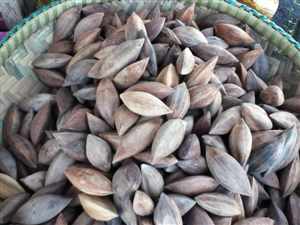Pili (Canarium ovatum)
Main Facts about Pili

Using Pili
Pili nuts are a good source of magnesium, phosphorus and Vitamin E. They are also high in calories and saturated fat. Pili nuts were traditionally used as an ointment for healing wounds and as a plaster. Raw nuts are a purgative. Recent studies results suggest a potential use of Pili for skin whitening. The amino acids in pili helps in balanced blood-sugar levels, development of muscle-tissue, hormones production and nerve-cell health. It also assist in the regulation of energy, support healthy bones and skin, liver detoxification and balance in the brain. Magnesium helps supports healthier nerves, bones and muscle. The omega fatty acids serves immune functions and aid in protection from various diseases including cardiovascular diseases by helping to prevent cholesterol before turning to plaque. The oil in Pili is similar to olive oil but it contains more beta carotene, which is more nutritious.Pili is a remedy for: Constipation
Cooking with Pili
The delicious nuts are edible, having a warm flavor much like that of a roasted pumpkin seed. They can be eaten raw, soaked or cooked, give smoothies a thick, buttery texture. The nuts are used in a variety of desserts, baked goods, and most commonly eaten roasted. Young shoots are used in salads, and the fruit pulp is eaten after it is boiled and seasoned. Boiled Pili pulp resembles the sweet potato in texture, it is oily and is considered to have food value similar to the avocado. Pulp oil can be used for cooking. Pili nuts are ground into a healthier alternative to chocolate.How to grow Pili
Pili is a tropical tree preferring warm temperatures and well-distributed rainfall. It cannot tolerate the slightest frost or low temperature. In its natural habitat it grows at low to medium altitudes in primary and secondary forests. Mature trees can resist strong winds. Pili is propagated by seed. The tree is fairly difficult to propagate other ways and only a small number of named varieties exist.| Peppermint |
Pine pollen
|